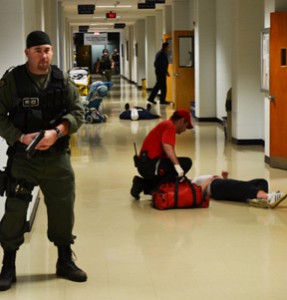By Katie Wootton
 Fierce shots ring out. Bodies litter the hallway floor. A gunman makes his way through the building. A voice comes over the loud speaker. “Attention. This is a drill. Attention—this is a drill. Campus is on lockdown. Lock your doors and remain in your secure area until the all clear is announced.” Local law enforcement agencies, fire departments and other first responders begin to arrive.
Fierce shots ring out. Bodies litter the hallway floor. A gunman makes his way through the building. A voice comes over the loud speaker. “Attention. This is a drill. Attention—this is a drill. Campus is on lockdown. Lock your doors and remain in your secure area until the all clear is announced.” Local law enforcement agencies, fire departments and other first responders begin to arrive.
This was the scene at West Virginia University (WVU) at Parkersburg as officials conducted a disaster drill on Wednesday, May 9, 2012.
Planning for the drill began in late March when the WVU Parkersburg safety committee contacted officials at local agencies to participate. This marks the third disaster drill the college has coordinated since 2007. Past scenarios involved a hostage situation, an anthrax threat and a shooter, and every drill occurred after college business hours.
“This year we decided to conduct the mock disaster during the morning because we thought it was important to get all faculty and staff involved for training purposes,” says Dave White, WVU Parkersburg safety coordinator and director of facilities and grounds. “We hold these drills to evaluate our ability to respond in a crisis situation. It gives us the chance to see what works and what doesn’t.”
Though the actual drill only took place from 9 a.m. to 11 a.m. the day of the event, extensive planning and coordination from all agencies involved were required to ensure that the drill ran smoothly and to keep all participants and bystanders safe.
The Wood County Sheriff’s Office coordinated with the local and state law enforcement to develop a scenario for the drill involving three shooters and approximately a dozen victims. To make the scenario more realistic for first responders, they requested that blank ammunition be used.
“We were okay with the blank ammunition as long as certain precautions were followed,” says White.
Deputies planned for each weapon to be inspected by three separate individuals immediately prior to the drill. WVU Parkersburg officials sent multiple messages to faculty, staff and students the week leading up to the event to advise them of the upcoming drill and make them aware that shots would be fired in the main building. Students were told that they would not be permitted inside the main building until after the drill was completed. On the day of the event, security personnel were positioned at each parking lot entrance to inform people of the ongoing drill.
As in years past, the college’s theater department coordinated student, faculty and staff volunteers to act as victims.
“We try to make the victims’ wounds look as convincing as possible,” says Jeff Byrd, a theater instructor at WVU Parkersburg. “I placed fake blood splatters in various locations on campus. We had a few fatalities and some other victims with superficial wounds.”
In addition to emergency personnel, counselors from Westbrook Health Services participated in the mock disaster as well as WVU Parkersburg’s student counselor Kurt Klettner.
“In a real-life disaster, there would likely be people on campus who would become panic-stricken or hysterical, and we would need to call in outside services for help,” says Klettner. “We anticipated that a few people might get upset at the realistic nature of the mock shooting scene, so we made ourselves available that day.”
To ensure the safety of volunteers and bystanders, five members of WVU Parkersburg’s safety committee acted as safety officers. These individuals wore neon vests and were positioned in various zones throughout the main building. Safety officers watched for anyone who might need counseling or emergency services and also kept people from entering the building after it was on lockdown.
Although police officials wrote the scenario, responders were not told the setup in advance.
“We didn’t give out any details,” says Captain Rick Woodyard of the Wood County Sheriff’s Office. “This was an opportunity to provide training to our officers and see how they perform in a situation like this. It also allowed us to evaluate our procedures and the corrections that need to be made. Overall, the scenario went well. All three shooters were dealt with, and EMS was able to tend to the victims on scene.”
WVU Parkersburg officials were pleased with how everyone responded to the drill and are now taking further steps to prepare for potential disasters, including purchasing a new emergency notification system specifically for the college’s campus and centers. The system would allow messages to be delivered campus-wide via web, mobile devices, social media, RSS feeds, e-mails, phone calls and public announcement systems within a matter of seconds.
“Overall I think this is the best drill that we’ve had,” says White. “Each time we do this we learn something new. It’s important to keep looking for ways to improve the safety of our campus and look out for the well-being of our students, faculty and staff.”
About the Author
 Katie Wootton is the director of marketing and communications for West Virginia University (WVU) at Parkersburg. She has a bachelor’s degree in journalism and a master’s degree in integrated marketing communications from West Virginia University. Prior to joining WVU Parkersburg, she worked as the marketing coordinator for the Clay Center for the Arts and Sciences in Charleston where she developed and implemented the center’s social media and e-mail marketing campaigns.
Katie Wootton is the director of marketing and communications for West Virginia University (WVU) at Parkersburg. She has a bachelor’s degree in journalism and a master’s degree in integrated marketing communications from West Virginia University. Prior to joining WVU Parkersburg, she worked as the marketing coordinator for the Clay Center for the Arts and Sciences in Charleston where she developed and implemented the center’s social media and e-mail marketing campaigns.








